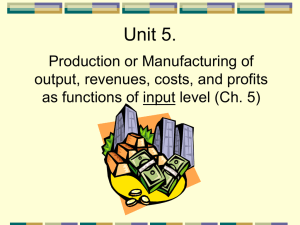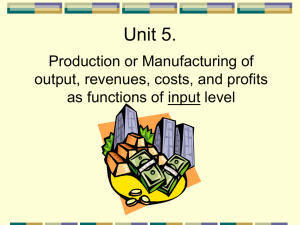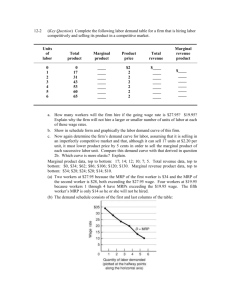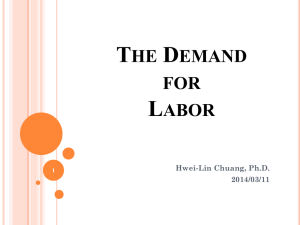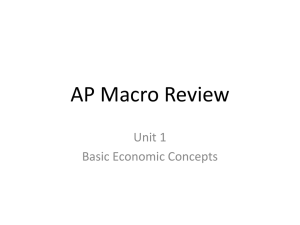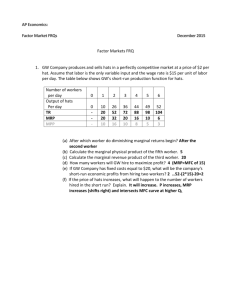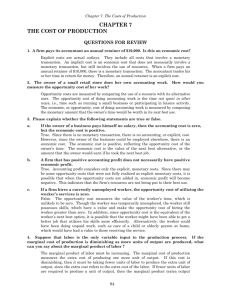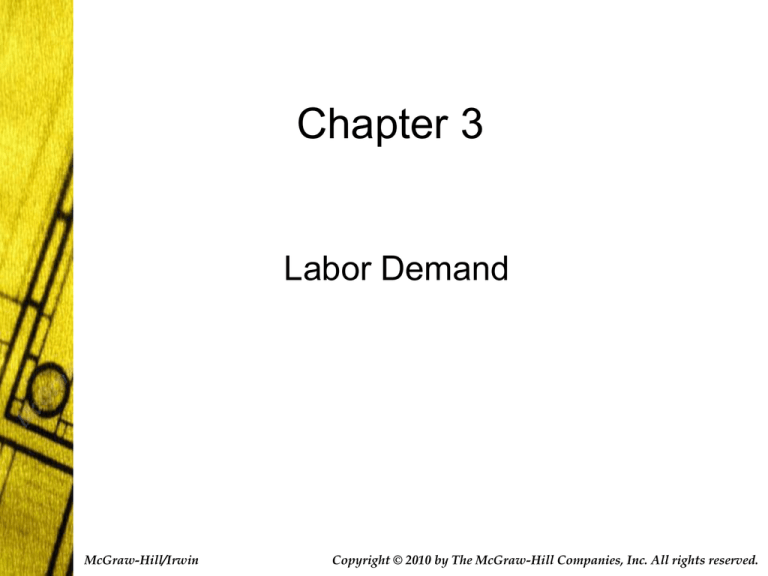
Chapter 3
Labor Demand
McGraw-Hill/Irwin
Copyright © 2010 by The McGraw-Hill Companies, Inc. All rights reserved.
Introduction
• Firms hire workers because consumers
want to purchase a variety of goods and
services.
• Demand for workers is derived from the
wants and desires of consumers.
• Central questions: how many workers are
hired and what are they paid?
3-2
The Firm’s Production Function
• Describes the technology that the firm uses to produce
goods and services.
• The firm’s output can be produced by a variety of
capital–labor combinations.
• The marginal product of labor is the change in output
resulting from hiring an additional worker, holding
constant the quantities of other inputs.
• The marginal product of capital is the change in output
resulting from hiring one additional unit of capital,
holding constant the quantities of other inputs.
3-3
The Total Product, the Marginal Product,
and the Average Product Curves
140
25
Average Product
120
20
Output
Output
100
80
Total Product
Curve
60
15
10
40
5
20
0
Marginal Product
0
0
2
4
6
8
10
Number of Workers
12
0
2
4
6
8
10
12
Number of Workers
The total product curve gives the relationship between output
and the number of workers hired by the firm (holding capital
fixed). The marginal product curve shows the output produced
by each additional worker, and the average product curve
shows output per worker.
3-4
Profit Maximization
• Objective of the firm is to maximize profits.
• The profit function is:
– Profits = pq – wE – rK
• Total Revenue = pq
• Total Costs = (wE + rk)
• Perfectly competitive firms cannot
influence prices of output or inputs.
3-5
MRP and MFC
• marginal revenue product (MRP) of
labor = the additional revenue that results
from the use of an additional unit of labor
• marginal factor cost (MFC) of labor =
the additional cost associated with the use
of an additional unit of labor
3-6
MRP, MFC and profit maximization
• a firm will use more labor if MRP > MFC
• a firm will use less labor if MRP < MFC
• a firm maximizes its profit at the level of
labor use at which MRP = MFC
3-7
MRP
MRP = MR x MP,
where:
Or:
3-8
Slope of MRP curve
• MRP = MR x MP
• MR is constant if the output market is
perfectly competitive and decreasing if the
output market is imperfectly competitive.
3-9
Short-run labor demand in a perfectly
competitive labor market
3-10
Short Run Hiring Decision
• Value of Marginal Product (VMP) is the
marginal product of labor times the dollar
value of the output.
• VMP indicates the dollar benefit derived
from hiring an additional worker, holding
capital constant.
• Value of Average Product is the dollar
value of output per worker.
3-11
Labor Demand Curve
• The demand curve for labor indicates how
many workers the firm hires for each
possible wage, holding capital constant.
• The labor demand curve is downward
sloping. This reflects the fact that
additional workers are costly and alter
average production due to the Law of
Diminishing Returns.
3-12
The Short-Run Demand Curve
for Labor
22
18
VMPE
VMPE
8
9
12
Number of Workers
Because marginal
product eventually
declines, the short-run
demand curve for labor is
downward sloping. A
drop in the wage from
$22 to $18 increases the
firm’s employment. An
increase in the price of
the output shifts the
value of marginal product
curve upward (to the
right), and increases
employment.
3-13
Maximizing Profits:
Two Rules
• The profit maximizing firm should produce
up to the point where the cost of producing
an additional unit of output (marginal cost)
is equal to the revenue obtained from
selling that output (marginal revenue).
• Marginal Productivity Condition: hire labor
up to the point where the value of marginal
product equals the added cost of hiring the
worker (i.e., the wage).
3-14
The Mathematics of Marginal
Productivity Theory
• The cost of producing an extra unit of
output:
– MC = w x (1 / MPe)
• The condition: produce to the point where
MC = P (for the competitive firm, P = MR)
– W x (1 / MPe) = P
3-15
The Firm's Output Decision
Dollars
MC
Output Price
p
q*
A profit-maximizing
firm produces up to
the point where the
output price equals
the marginal cost of
production.
Output
3-16
The Employment Decision in
the Long Run
• In the long run, the firm maximizes profits
by choosing how many workers to hire
AND how much plant and equipment to
invest in.
• Isoquant curves describe the possible
combinations of labor and capital that
produce the same level of output.
3-17
Isoquant Curves
Capital
X
K
Y
q1
q0
E
All capital-labor
combinations that lie on a
single isoquant produce
the same level of output.
The input combinations
at points X and Y
produce q0 units of
output. Combinations of
input bundles that lie on
higher isoquants must
produce more output.
Employment
3-18
Isocost Lines
• The isocost line indicates all labor–capital
bundles that exhaust a specified budget
for the firm.
• Isocost lines indicate equally costly
combinations of inputs.
• Higher isocost lines indicate higher costs.
3-19
Isocost Lines
Capital
C1/r
C0/r
Isocost with Cost Outlay C1
Isocost with Cost Outlay C0
C0/w
C1/w
All capital-labor
combinations that lie on a
single isocost curve are
equally costly. Capitallabor combinations that
lie on a higher isocost
curve are more costly.
The slope of an isoquant
equals the ratio of input
prices (-w/r).
Employment
3-20
Cost Minimization
• Profit maximization implies cost minimization.
• The firm chooses the least-cost combination of
capital and labor.
• This least-cost choice is where the isocost line is
tangent to the isoquant.
• Marginal rate of substitution equals the ratio of
input prices, w / r, at the least-cost choice.
3-21
Long Run Demand for Labor
• When the wage drops, two effects arise.
– The firm takes advantage of the lower price of
labor by expanding production (the scale
effect).
– The firm takes advantage of the wage change
by rearranging its mix of inputs even if holding
output constant (the substitution effect)
3-22
Elasticity of Substitution
• The elasticity of substitution is the
percentage change in the capital to labor
ratio given a percentage change in the
price ratio (wages to real interest).
– Formula: %∆(K/L) %∆(w/r).
– Interpret a particular elasticity of substitution
number as the percentage change in the
capital–labor ratio given a 1% change in the
relative price of labor to capital
3-23
Elasticity of Substitution
• Example:
If the elasticity of substitution is 5, then a
10% increase in the ratio of wages to the
price of capital would result in the firm
increasing its capital-to-labor ratio by 50%.
3-24
Long Run Demand Curve for
Labor
Dollars
The long-run demand curve
for labor gives the firm’s
employment at a given wage
and is downward sloping.
w0
w1
DLR
25
50
Employment
3-25
Marshall’s Rules
• Labor Demand is more elastic when:
– The elasticity of substitution is greater.
– The elasticity of demand for the firm’s output
is greater.
– Labor’s share in total costs of production is
greater.
– The elasticity of supply of other factors of
production such as capital is greater.
3-26
Factor Demands when there
are Several Inputs
• There are many different inputs.
– Skilled and unskilled labor
– Old and young
– Old and new machines
• Cross-elasticity of factor demand.
– %∆Di%∆wj
– If cross-elasticity is positive, the two inputs are
said to be substitutes in production.
3-27
Labor Market Equilibrium
Dollars
Supply
whigh
w*
wlow
Demand
ED
E*
ES
In a competitive labor
market, equilibrium is
attained at the point
where supply equals
demand. The marketclearing wage is w* at
which E* workers are
employed.
Employment
3-28
Application: The Employment
Effects of Minimum Wages
• The unemployment rate is higher the
higher the minimum wage and the more
elastic are the labor supply and demand
curves.
• The benefits of the minimum wage accrue
mostly to workers who are not at the
bottom of the distribution of permanent
income.
3-29
End of Chapter 3
3-30

